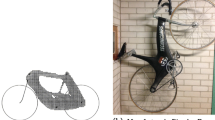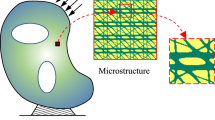Abstract
This paper describes a versatile methodology for solving topology design optimization problems using a genetic algorithm (GA). The key to its effectiveness is a geometric representation scheme that works by specifying a skeleton which defines the underlying topology/connectivity of a structural continuum together with segments of material surrounding the skeleton. The required design variables are encoded in a chromosome which is in the form of a directed graph that embodies this underlying topology so that appropriate crossover and mutation operators can be devised to recombine and help preserve any desirable geometry characteristics of the design through succeeding generations in the evolutionary process. The overall methodology is first tested by solving ‘target matching’ problems—simulated topology optimization problems in each of which a ‘target’ geometry is first created and predefined as the optimum solution, and the objective of the optimization problem is to evolve design solutions to converge towards this target shape. The methodology is then applied to design two path-generating compliant mechanisms—large-displacement flexural structures that undergo some desired displacement paths at some point when given a straight line input displacement at some other point—by an actual process of topology/shape optimization.
Similar content being viewed by others
References
Akhtar S, Tai K, Prasad J (2002) Topology optimization of compliant mechanisms using evolutionary algorithm with design geometry encoded as a graph. Presented at the 2002 ASME Design Engineering Technical Conferences, Montreal, Canada, September 29–October 2, 2002, paper no. DETC2002/DAC-34147
Atrek E (1989) SHAPE: A program for shape optimization of continuum structures. In: Brebbia CA, Hernandez S (eds) Computer aided optimum design of structures: applications. Southampton, Computational Mechanics, pp 135–144
Bendsøe MP, Kikuchi N (1988) Generating optimal topologies in structural design using a homogenization method. Comput Methods Appl Mech Eng 71:197–224
Chapman CD, Jakiela MJ (1996) Genetic algorithm-based structural topology design with compliance and topology simplification considerations. ASME J Mech Des 118:89–98
Chapman CD, Saitou K, Jakiela MJ (1994) Genetic algorithms as an approach to configuration and topology design. ASME J Mech Des 116:1005–1012
Cui GY, Tai K, Wang BP (2002) Topology optimization for maximum natural frequency using simulated annealing and morphological representation. AIAA J 40(3):586–589
Deb K (2001) Multi-objective optimization using evolutionary algorithms. Wiley, Chichester
Frecker MI, Ananthasuresh GK, Nishiwaki S, Kikuchi N, Kota S (1997) Topological synthesis of compliant mechanisms using multi-criteria optimization. ASME J Mech Des 119:238–245
Goldberg DE (1989) Genetic algorithms in search, optimization and machine learning. Addison-Wesley, Reading, Massachusetts
Gross J, Yellen J (1999) Graph theory and its applications. CRC, Boca Raton
Hamda H, Jouve F, Lutton E, Schoenauer M, Sebag M (2002) Compact unstructured representations for evolutionary design. Appl Int 16(2):139–155
Hetrick JA, Kota S (1999) An energy formulation for parametric size and shape optimization of compliant mechanisms. ASME J Mech Des 121:229–234
Howell LL (2001) Compliant mechanisms. Wiley, New York
Jakiela MJ, Chapman C, Duda J, Adewuya A, Saitou K (2000) Continuum structural topology design with genetic algorithms. Comput Methods Appl Mech Eng 186(2–4):339–356
Kane C, Schoenauer M (1996) Topological optimum design using genetic algorithms. Control Cybern 25(5):1059–1088
Larsen UD, Sigmund O, Bouwstra S (1997) Design and fabrication of compliant micromechanisms and structures with negative Poisson’s ratio. J Microelectromech Syst 6:99–106
Liu JS, Parks GT, Clarkson PJ (2000) Metamorphic development: a new topology optimization method for continuum structures. Struct Multidisc Optim 20:288–300
Mortenson ME (1997) Geometric modeling, 2nd edn. Wiley, New York
Parsons R, Canfield SL (2002) Developing genetic programming techniques for the design of compliant mechanisms. Struct Multidisc Optim 24:78–86
Pedersen CBW, Buhl T, Sigmund O (2001) Topology synthesis of large-displacement compliant mechanisms. Int J Numer Methods Eng 50:2683–2705
Ray T, Tai K, Seow KC (2001) Multiobjective design optimization by an evolutionary algorithm. Eng Optim 33:399–424
Rozvany GIN (1981) Optimality criteria for grids, shells and arches. in: haug ej, cea J (eds.) Optimization of distributed parameter structures: vol. 1—Proceedings of the NATO Advanced Study Institute, Sijthoff & Noordhoff, Alphen aan den Rijn (the Netherlands), pp 112–151
Rozvany GIN (2001a) Aims, scope, methods, history and unified terminology of computer-aided topology optimization in structural mechanics. Struct Optim 21:90–108
Rozvany GIN (2001b) Stress ratio and compliance based methods in topology optimization—a critical review. Struct Optim 21:109–119
Rozvany GIN, Zhou M, Birker T (1992) Generalized shape optimization without homogenization. Struct Optim 4:250–254
Russell DM, Manoochehri SP (1989) A two dimensional rule-based shape synthesis method. In: Ravani B (ed.) Advances in design automation, 1989, Vol. 2, Design Optimization. ASME, New York, pp 217–223
Saxena A, Ananthasuresh GK (2001) Topology synthesis of compliant mechanisms for nonlinear force-deflection and curved path specifications. ASME J Mech Des 123:33–42
Schoenauer M (1995) Shape representation for evolutionary optimization and identifcation in structural mechanics. In: Winter G, Periaux J, Galan M, Cuesta P (eds.) Genetic Algorithms in engineering and computer science. Wiley, Chichester, pp 443–464
Sigmund O (1997) On the design of compliant mechanisms using topology optimization. Mech Struct Mach 25:493–524
Sigmund O (2001) A 99 line topology optimization code written in MATLAB. Struct Multidisc Optim 21(2):120–127
Soto CA (2001) Structural topology optimization: from minimizing compliance to maximizing energy absorption. Int J Vehicle Des 25(1/2):142–163
Tai K, Chee TH (1998) Genetic algorithm with structural morphology representation for topology design optimization. In: Gentle CR, Hull JB (eds.) Mechanics in design—Proceedings of the 2nd international conference on mechanics in design, Nottingham, pp 827–836
Tai K, Chee TH (2000) Design of structures and compliant mechanisms by evolutionary optimization of morphological representations of topology. ASME J Mech Des 122:560–566
Tai K, Cui GY, Ray T (2002) Design synthesis of path generating compliant mechanisms by evolutionary optimization of topology and shape. ASME J Mech Des 124(3):492–500
Xie YM, Steven GP (1993) A simple evolutionary procedure for structural optimization. Comput Struct 49:885–896
Yang RJ, Chuang CH (1994) Optimal topology design using linear programming. Comput Struct 52:265–275
Author information
Authors and Affiliations
Corresponding author
Rights and permissions
About this article
Cite this article
Tai, K., Akhtar, S. Structural topology optimization using a genetic algorithm with a morphological geometric representation scheme. Struct Multidisc Optim 30, 113–127 (2005). https://doi.org/10.1007/s00158-004-0504-y
Received:
Revised:
Published:
Issue Date:
DOI: https://doi.org/10.1007/s00158-004-0504-y




